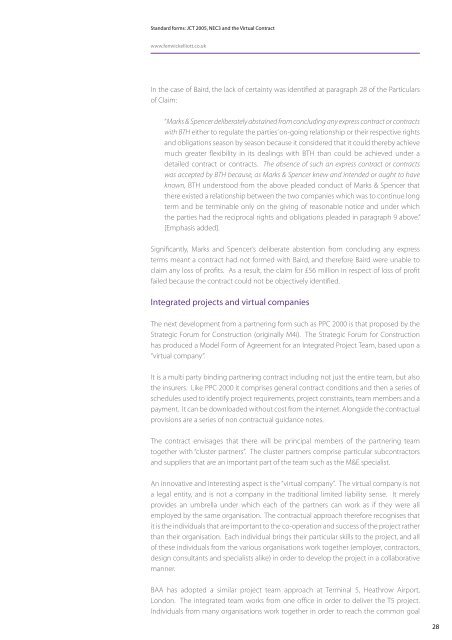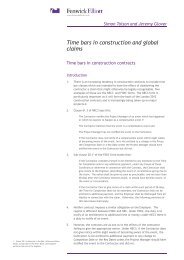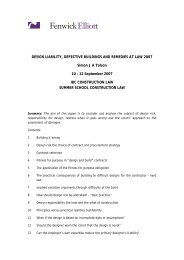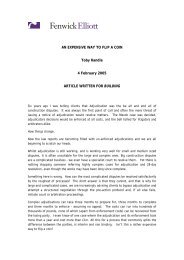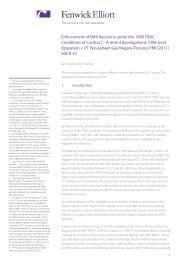Standard forms: JCT 2005, NEC3 and the Virtual ... - Fenwick Elliott
Standard forms: JCT 2005, NEC3 and the Virtual ... - Fenwick Elliott
Standard forms: JCT 2005, NEC3 and the Virtual ... - Fenwick Elliott
Create successful ePaper yourself
Turn your PDF publications into a flip-book with our unique Google optimized e-Paper software.
<strong>St<strong>and</strong>ard</strong> <strong>forms</strong>: <strong>JCT</strong> <strong>2005</strong>, <strong>NEC3</strong> <strong>and</strong> <strong>the</strong> <strong>Virtual</strong> Contract<br />
www.fenwickelliott.co.uk<br />
In <strong>the</strong> case of Baird, <strong>the</strong> lack of certainty was identified at paragraph 28 of <strong>the</strong> Particulars<br />
of Claim:<br />
“Marks & Spencer deliberately abstained from concluding any express contract or contracts<br />
with BTH ei<strong>the</strong>r to regulate <strong>the</strong> parties’ on-going relationship or <strong>the</strong>ir respective rights<br />
<strong>and</strong> obligations season by season because it considered that it could <strong>the</strong>reby achieve<br />
much greater flexibility in its dealings with BTH than could be achieved under a<br />
detailed contract or contracts. The absence of such an express contract or contracts<br />
was accepted by BTH because, as Marks & Spencer knew <strong>and</strong> intended or ought to have<br />
known, BTH understood from <strong>the</strong> above pleaded conduct of Marks & Spencer that<br />
<strong>the</strong>re existed a relationship between <strong>the</strong> two companies which was to continue long<br />
term <strong>and</strong> be terminable only on <strong>the</strong> giving of reasonable notice <strong>and</strong> under which<br />
<strong>the</strong> parties had <strong>the</strong> reciprocal rights <strong>and</strong> obligations pleaded in paragraph 9 above.”<br />
[Emphasis added].<br />
Significantly, Marks <strong>and</strong> Spencer’s deliberate abstention from concluding any express<br />
terms meant a contract had not formed with Baird, <strong>and</strong> <strong>the</strong>refore Baird were unable to<br />
claim any loss of profits. As a result, <strong>the</strong> claim for £56 million in respect of loss of profit<br />
failed because <strong>the</strong> contract could not be objectively identified.<br />
Integrated projects <strong>and</strong> virtual companies<br />
The next development from a partnering form such as PPC 2000 is that proposed by <strong>the</strong><br />
Strategic Forum for Construction (originally M4i). The Strategic Forum for Construction<br />
has produced a Model Form of Agreement for an Integrated Project Team, based upon a<br />
“virtual company”.<br />
It is a multi party binding partnering contract including not just <strong>the</strong> entire team, but also<br />
<strong>the</strong> insurers. Like PPC 2000 it comprises general contract conditions <strong>and</strong> <strong>the</strong>n a series of<br />
schedules used to identify project requirements, project constraints, team members <strong>and</strong> a<br />
payment. It can be downloaded without cost from <strong>the</strong> internet. Alongside <strong>the</strong> contractual<br />
provisions are a series of non contractual guidance notes.<br />
The contract envisages that <strong>the</strong>re will be principal members of <strong>the</strong> partnering team<br />
toge<strong>the</strong>r with “cluster partners”. The cluster partners comprise particular subcontractors<br />
<strong>and</strong> suppliers that are an important part of <strong>the</strong> team such as <strong>the</strong> M&E specialist.<br />
An innovative <strong>and</strong> interesting aspect is <strong>the</strong> “virtual company”. The virtual company is not<br />
a legal entity, <strong>and</strong> is not a company in <strong>the</strong> traditional limited liability sense. It merely<br />
provides an umbrella under which each of <strong>the</strong> partners can work as if <strong>the</strong>y were all<br />
employed by <strong>the</strong> same organisation. The contractual approach <strong>the</strong>refore recognises that<br />
it is <strong>the</strong> individuals that are important to <strong>the</strong> co-operation <strong>and</strong> success of <strong>the</strong> project ra<strong>the</strong>r<br />
than <strong>the</strong>ir organisation. Each individual brings <strong>the</strong>ir particular skills to <strong>the</strong> project, <strong>and</strong> all<br />
of <strong>the</strong>se individuals from <strong>the</strong> various organisations work toge<strong>the</strong>r (employer, contractors,<br />
design consultants <strong>and</strong> specialists alike) in order to develop <strong>the</strong> project in a collaborative<br />
manner.<br />
BAA has adopted a similar project team approach at Terminal 5, Heathrow Airport,<br />
London. The integrated team works from one office in order to deliver <strong>the</strong> T5 project.<br />
Individuals from many organisations work toge<strong>the</strong>r in order to reach <strong>the</strong> common goal<br />
28


